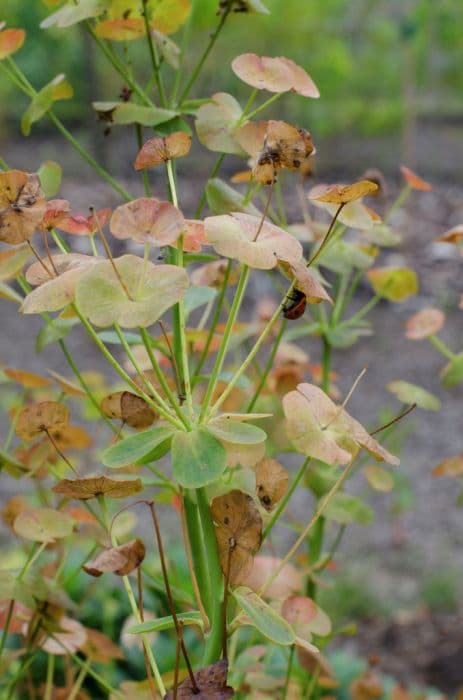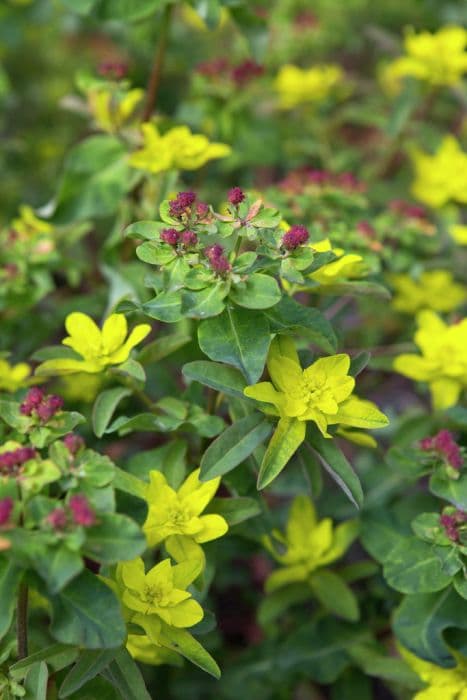Griffith's spurge Euphorbia griffithii 'Dixter'

ABOUT
Euphorbia griffithii 'Dixter' is a vibrant perennial known for its striking appearance. It has a clumping growth habit, with multiple upright stems that support a bushy array of foliage and flowers. The leaves of this plant are lance-shaped, offering a rich green background that sometimes shows hints of reddish-bronze, particularly on the new growth or when positioned in the full sun, which brings out the color. As the seasons progress, the leaves can turn to a more fiery orange or red, mirroring the warm tones of autumn. The most distinctive feature of 'Dixter' is its flowers, or more correctly, the showy bracts that surround the rather inconspicuous true flowers. These bracts are a bright fiery orange to red hue, creating a bold contrast against the green leaves. They typically bloom in spring and early summer, providing a vivid display that is both eye-catching and long-lasting. The bracts are arranged in complex structures known as cyathia, which give the impression of single large flowers at the tops of the stems. Completing the look of this Euphorbia griffithii variety are the stems themselves, which can have a reddish tint, harmonizing with the red-orange floral display. The overall impression is a plant that provides strong visual interest throughout its growing season, whether through its foliage or its vibrant floral bracts. As with all euphorbias, when cut or broken, the stems exude a milky sap that should be handled with care, as it can be an irritant to the skin and eyes.
About this plant
 Names
NamesFamily
Euphorbiaceae
Synonyms
Griffith's Spurge, Dixter Spurge
Common names
Euphorbia griffithii 'Dixter'
 Toxicity
ToxicityTo humans
Spurge is known for its toxic milky sap, which is present throughout the plant. If ingested, the sap can cause severe irritation to the mouth, throat, and stomach, leading to symptoms like burning pain, swelling, and in severe cases, difficulty in swallowing or breathing. Symptoms from skin contact with the sap can include redness, swelling, and blisters. In the eyes, exposure can result in pain, redness, and even temporary blindness. It is essential to handle this plant with care and to seek medical attention if sap exposure occurs.
To pets
Spurge is toxic to pets due to its milky sap, containing compounds that can irritate the skin and mucous membranes. If a pet ingests part of the plant, they could suffer from symptoms such as vomiting, diarrhea, and drooling. In worst-case scenarios, ingesting the sap may lead to more severe reactions, including difficulty breathing or swallowing, particularly if the sap reaches their throat. Contact with the sap can also cause skin or eye irritation. Pet owners should prevent their animals from chewing on the plant and consult a veterinarian immediately if ingestion is suspected.
 Characteristics
CharacteristicsLife cycle
Perennials
Foliage type
Deciduous
Color of leaves
Green
Flower color
Orange
Height
2 feet (60 cm)
Spread
2 feet (60 cm)
Plant type
Herb
Hardiness zones
6
Native area
Himalayas
Benefits
 General Benefits
General Benefits- Attracts Pollinators: Euphorbia griffithii 'Dixter', commonly known as Griffith's spurge, attracts bees and butterflies, supporting local ecosystems.
- Drought Tolerant: Once established, it is relatively drought resistant, making it suitable for xeriscaping or regions with low water availability.
- Low Maintenance: Griffith's spurge requires minimal care, making it an excellent choice for gardeners seeking an easy-to-maintain plant.
- Color and Aesthetic Appeal: With its fiery orange-red flowers, it adds vibrant color to gardens and landscapes, enhancing visual interest.
- Disease and Pest Resistance: This plant exhibits a natural resistance to many common pests and diseases, reducing the need for chemical treatments.
- Soil Adaptability: It can adapt to a range of soil types, although it prefers well-drained soil, making it versatile for different garden settings.
 Medical Properties
Medical PropertiesThis plant is not used for medical purposes.
 Air-purifying Qualities
Air-purifying QualitiesThis plant is not specifically known for air purifying qualities.
 Other Uses
Other Uses- Euphorbia griffithii 'Dixter', commonly known as Spurge, can be used as a natural dye for fabrics and textiles, as it can produce a rich orange or reddish color.
- Its sap contains compounds that can be used as a traditional fishing aid in some cultures, stupefying fish to make them easier to catch.
- The rigid stems of Spurge can be utilized in basket weaving and other types of craftwork after they have been dried out and treated.
- In the horticulture industry, Spurge is sometimes used for creating hybrid species or cultivars due to its distinctive floral structures and coloration.
- The plant is occasionally used in landscape design not only for its aesthetic appeal but also as a barrier due to its toxic sap deterring some animal pests.
- Spurge has been used in educational settings, such as botany classes, to demonstrate plant defense mechanisms, especially its toxic latex sap when handling the plant.
- It can serve as a natural seasonal indicator, as it flowers and changes color with the seasons, which can be helpful in planning garden maintenance and activities.
- The unique flowering structure of Spurge makes it a popular subject for photographers and artists, who may use the plant as inspiration or focal point in their work.
- In a controlled environment, the plant can be used for erosion control, as its root system can help stabilize soil on slopes and banks.
- The plant may be incorporated in living fences or hedges in rural areas where traditional fencing materials are not easily accessible.
Interesting Facts
 Feng Shui
Feng ShuiThe Fireglow spurge is not used in Feng Shui practice.
 Zodiac Sign Compitability
Zodiac Sign CompitabilityThe Fireglow spurge is not used in astrology practice.
 Plant Symbolism
Plant Symbolism- Resilience: Euphorbia griffithii 'Dixter', commonly known as Griffith's spurge, is known for its hardy nature and ability to thrive in various conditions, symbolizing the human ability to persist and adapt.
- Healing: Many Euphorbia species have been used in traditional medicine, implying a connection to healing both physical and emotional wounds.
- Protection: The milky sap of Euphorbia griffithii 'Dixter' is toxic and can create a protective barrier against herbivores, representing protection against harmful external influences.
- Transformation: The bright fire-like blooms can symbolize transformation and change, reflective of its stunning seasonal color changes.
- Caution: Due to the plant's toxic sap and potential skin irritants, it also symbolizes the need for caution, careful handling, and respect for boundaries.
 Water
WaterFireglow Spurge requires consistent moisture, particularly during spring and early summer when the plant is actively growing. It should be watered thoroughly, allowing water to penetrate deeply into the soil, approximately once a week. The exact frequency of watering will depend on climate and soil conditions, but as a general rule of thumb, aim to apply about 1 inch of water weekly during the growing season. During hot, dry spells, you may need to water more frequently to prevent the soil from drying out completely. In the winter, when the plant is dormant, reduce watering significantly, providing just enough to keep the soil from becoming bone dry.
 Light
LightFireglow Spurge thrives in full sun to partial shade. Ideally, it should be planted in a location where it receives at least 6 hours of sunlight a day. However, in extremely hot climates, some afternoon shade can be beneficial to prevent scorching of the foliage. If grown indoors, a sunny window with some direct light will be the best spot to promote healthy growth.
 Temperature
TemperatureFireglow Spurge favors temperate climates and can tolerate a range of temperatures. It can survive minimum temperatures down to around 0 degrees Fahrenheit, but prefers a more comfortable range between 60 and 75 degrees Fahrenheit for ideal growth. Protection from severe frost is necessary, as extreme cold can damage or kill the plant.
 Pruning
PruningPruning Fireglow Spurge is mainly done to remove spent flowers and maintain plant shape. Prune in late summer or early fall, after the plant has finished flowering, to encourage healthy growth and prepare the plant for the next blooming season. Pruning can also be done in the spring to remove any winter damage. Deadheading, or removing faded flowers, can be done throughout the growing season to keep the plant looking tidy.
 Cleaning
CleaningAs needed
 Soil
SoilFireglow Spurge prefers well-draining soil with a pH of around 6.5 to 7.5. A mixture of garden soil, peat, and perlite in equal parts is ideal to ensure good drainage and aeration.
 Repotting
RepottingFireglow Spurge should be repotted every 2 to 3 years. It's best to repot in spring just as the growing season begins.
 Humidity & Misting
Humidity & MistingFireglow Spurge thrives in average humidity conditions. It prefers humidity levels similar to those found in a typical outdoor garden environment.
 Suitable locations
Suitable locationsIndoor
Place in bright light, limit watering, and ensure pot has drainage.
Outdoor
Plant in sunny spot, well-draining soil, water moderately.
Hardiness zone
5-9 USDA.
 Life cycle
Life cycleEuphorbia griffithii 'Dixter,' commonly known as Griffith's spurge, begins its life as a seed, which, once in contact with moist soil and under the right conditions, germinates. The seedling develops into a young plant with distinguishing features such as reddish stems and green leaves. As it enters the vegetative stage, the plant grows rapidly, with leaves and stems becoming more robust and sturdy. The next stage is the flowering phase, where Griffith's spurge produces vibrant orange-red flowers typically from late spring to early summer, attracting pollinators. After pollination, the flowers develop into fruit that releases seeds when mature, completing the reproductive cycle. Finally, in the perennial stages of its life, the plant goes dormant during the winter, retreating to the root system, and re-emerges in the following spring to repeat the cycle.
 Propogation
PropogationPropogation time
Spring to early summer
Euphorbia griffithii 'Dixter', commonly known as Griffith's Spurge, is most successfully propagated by division, a method that is straightforward and readily accessible to most gardeners. This process is usually done in the spring, as new growth appears, which makes it easier to see the natural divisions within the plant. The gardener should gently lift the clump from the ground using a garden fork, taking care not to damage the root system. Then, with sharp, clean cuts, sections of the plant are divided, ensuring that each piece has a portion of the root system. These sections are then replanted in well-draining soil and kept moist until the plant is established. It's crucial that each new plant has enough roots to sustain itself and at least one or two growing points to ensure successful growth. Divided plants should be spaced about 12 inches (approximately 30 centimeters) apart to give them room to grow.


![Spurge [Silver Swan]](/_next/image?url=https%3A%2F%2Fplants-admin.emdemapps.com%2Fimages%2Fplants%2F%2Fimages%2F604b573f6c8f6.png&w=640&q=75)






